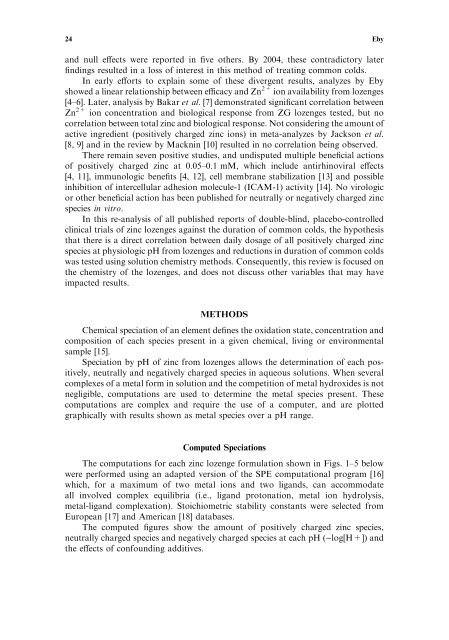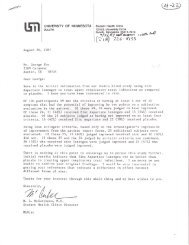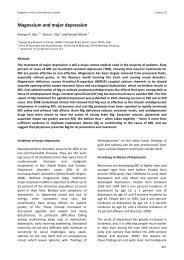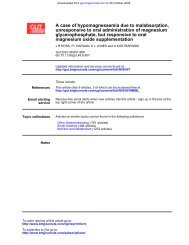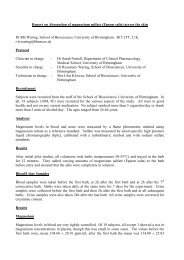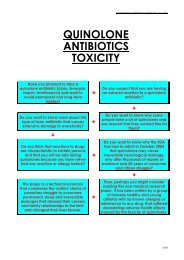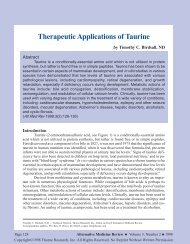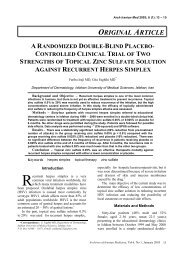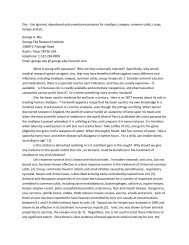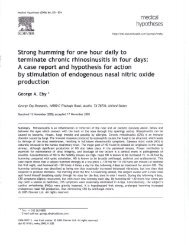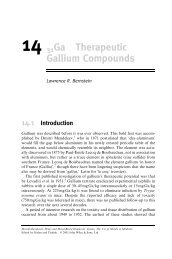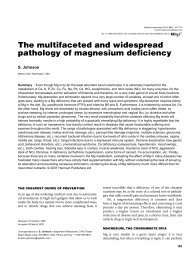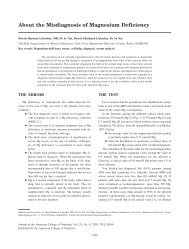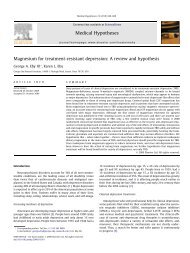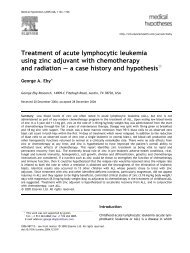Zinc Lozenges: Cold Cure or Candy? - Bioscience Reports
Zinc Lozenges: Cold Cure or Candy? - Bioscience Reports
Zinc Lozenges: Cold Cure or Candy? - Bioscience Reports
Create successful ePaper yourself
Turn your PDF publications into a flip-book with our unique Google optimized e-Paper software.
24 Eby<br />
and null effects were rep<strong>or</strong>ted in five others. By 2004, these contradict<strong>or</strong>y later<br />
findings resulted in a loss of interest in this method of treating common colds.<br />
In early eff<strong>or</strong>ts to explain some of these divergent results, analyzes by Eby<br />
showed a linear relationship between efficacy and Zn 2+ ion availability from lozenges<br />
[4–6]. Later, analysis by Bakar et al. [7] demonstrated significant c<strong>or</strong>relation between<br />
Zn 2+ ion concentration and biological response from ZG lozenges tested, but no<br />
c<strong>or</strong>relation between total zinc and biological response. Not considering the amount of<br />
active ingredient (positively charged zinc ions) in meta-analyzes by Jackson et al.<br />
[8, 9] and in the review by Macknin [10] resulted in no c<strong>or</strong>relation being observed.<br />
There remain seven positive studies, and undisputed multiple beneficial actions<br />
of positively charged zinc at 0.05–0.1 mM, which include antirhinoviral effects<br />
[4, 11], immunologic benefits [4, 12], cell membrane stabilization [13] and possible<br />
inhibition of intercellular adhesion molecule-1 (ICAM-1) activity [14]. No virologic<br />
<strong>or</strong> other beneficial action has been published f<strong>or</strong> neutrally <strong>or</strong> negatively charged zinc<br />
species in vitro.<br />
In this re-analysis of all published rep<strong>or</strong>ts of double-blind, placebo-controlled<br />
clinical trials of zinc lozenges against the duration of common colds, the hypothesis<br />
that there is a direct c<strong>or</strong>relation between daily dosage of all positively charged zinc<br />
species at physiologic pH from lozenges and reductions in duration of common colds<br />
was tested using solution chemistry methods. Consequently, this review is focused on<br />
the chemistry of the lozenges, and does not discuss other variables that may have<br />
impacted results.<br />
METHODS<br />
Chemical speciation of an element defines the oxidation state, concentration and<br />
composition of each species present in a given chemical, living <strong>or</strong> environmental<br />
sample [15].<br />
Speciation by pH of zinc from lozenges allows the determination of each positively,<br />
neutrally and negatively charged species in aqueous solutions. When several<br />
complexes of a metal f<strong>or</strong>m in solution and the competition of metal hydroxides is not<br />
negligible, computations are used to determine the metal species present. These<br />
computations are complex and require the use of a computer, and are plotted<br />
graphically with results shown as metal species over a pH range.<br />
Computed Speciations<br />
The computations f<strong>or</strong> each zinc lozenge f<strong>or</strong>mulation shown in Figs. 1–5 below<br />
were perf<strong>or</strong>med using an adapted version of the SPE computational program [16]<br />
which, f<strong>or</strong> a maximum of two metal ions and two ligands, can accommodate<br />
all involved complex equilibria (i.e., ligand protonation, metal ion hydrolysis,<br />
metal-ligand complexation). Stoichiometric stability constants were selected from<br />
European [17] and American [18] databases.<br />
The computed figures show the amount of positively charged zinc species,<br />
neutrally charged species and negatively charged species at each pH ()log[H+]) and<br />
the effects of confounding additives.


